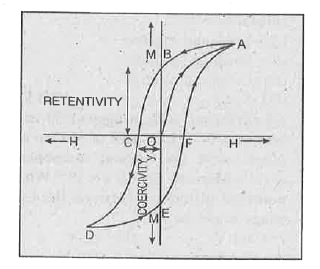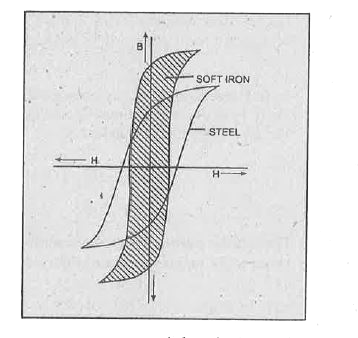(a) What do you mean by Hysteresis ? Explain.
(b) Discuss some uses of the study of hysteresis studies.
Text Solution
(a) Hysteresis. The lagging of intensity of magnetisation behind the magnetising field is called hysteresis. To explain term hysteresis, suppose a bar of iron is magnetised slowly. The intensity of magnetisation M increases with increase in the strength of magnetising field along OA as shown in the figure. At A, any further increase in H does not produce any increase in M and therefore, corresponding to point A, the bar has acquired a state of magnetic saturation. If the magnetising field is now decreased slowly, the intensity of magnetisation also decreases but corresponding to point B when H becomes zero the intensity of magnetisation does not become zero.
The value of intensity of magnetisation retained by the magnetic material, even when the magnetising field is reduced to zero is called its retentivity or remanent magnetism or residual magnetism.
Thus, OB represents the retentivity of the material under study. If now the direction of magnetising field is reversed, the intensity of magnetisation reduces along BC till it becomes zero at C. Thus to reduce the residual magnetism to zero, magnetising filed equal to OC has to be applied in reverse direction.
The value of the reverse magnetising field which is to be applied to the magnetic material so as to reduce the residual magnetism to zero is called its coercivity.

When the magnetising field is further increased in reverse direction, the intensity of magnetisation increases along CD till corresponding to point B, it again acquires saturation value symmetrical to point A. On increasing the field again, the intensity of magnetisation follows the path DEFA, and the closed curve ABCDEFA is obtained for complete cycle of magnetisation. This closed curve is known as hysteresis loop. On repeating the process, the same closed curve is obtained again and again but portion OA is never obtained.
Corresponding to point B, H is zero but M has still some finite value and becomes zero after increasing H in reverse direction. Therefore, intensity of magnetisation does not become zero on making magnetising field zero but does so a little and this effect is called hysteresis.
(b) Uses. When a ferromagnetic substance is taken over a complete cycle of magnetisation, the energy spent per unit volume is numerically equal to the area of the hysteresis loop.

1. The shape of the hysteresis loop is characteristic of the magnetic materials. For example, for soft iron, the hysteresis loop is narrow and large in height, while that for steel, it is quite wide and small in height, while that for steel, it is quite wide and small in height, [as shown in the fig.] The area of hysteresis loop for soft iron is found to be much smaller than for steel. Due to this, the loss of energy in case of soft iron bar will be very small as compared to that in case of steel, when both are taken over complete cycle of magnetisation. On account of this, soft iron is used to make the core of transformers and generators. Silicon, iron and mumetal (76% nickel, 17 % iron and small percentage of copper and chromium) also possess narrow hysteresis loop and can be used to make the core of a transformer.
2. Due to high value of coercivity and fairly large value of retentivity, steel is used to make permanent magnets. The area of hysteresis loop is large for steel but it is of no consideration as a permanent magnet has never to be taken through a cycle of magnetisation. Materials suitable for making permanent magnets are cobalt steel (containing cobalt, tungsten and carbon) chromium, steel, tungsten steel. The alloy alnico (54% iron, 18% nickel, 10% aluminium, 12% cobalt, and 6% copper) is also very suitable for making permanent magnets. The only disadvantage is that alnico is brittle.
3. For soft iron, coercivity is very small and area of hysteresis loop is very small. Because of these characteristics soft iron is an ideal material for making electromagnets.
|
Updated on:21/07/2023
Topper's Solved these Questions
- BOOK - MBD -HARYANA BOARDCHAPTER - MAGNETISMEXERCISE - OBJECTIVE TYPE QUESTIONS17videos
MAGNETISM
- BOOK - MBD -HARYANA BOARDCHAPTER - MAGNETISMEXERCISE - SHORT ANSWER TYPE QUESTIONS4videos
MAGNETISM
- BOOK - MBD -HARYANA BOARDCHAPTER - ELECTROSTATICSEXERCISE - OBJECTIVE TYPE QUESTIONS23videos
ELECTROSTATICS
- BOOK - MBD -HARYANA BOARDCHAPTER - MODEL TEST PAPER (SOLVED)EXERCISE - LONG ANSWER TYPE QUESTIONS6videos
MODEL TEST PAPER (SOLVED)
Similar Questions
What do you mean by disaster? Explain in detail
View SolutionWhat do you mean by food poisoning? Explain.
View SolutionWhat do you mean by absorption of food? Explain.
View SolutionWhat is the basic use of hysteresis curve?
View SolutionWhat is the basic use of hysteresis curve?
View SolutionExplain the term hysteresis.
View SolutionWhat is meant by hysteresis loss? Where is the study of hysteresis used?
View SolutionWhat is meant by hysteresis? Discuss briefly the dissipation of energy due to hysteresis. Draw hysteresis curves to soft iron and steel.
View SolutionExplain what do you mean by suspension culture.
View SolutionWhat is Hysteresis loop ? Explain with the help of terms related to it.
View Solution

